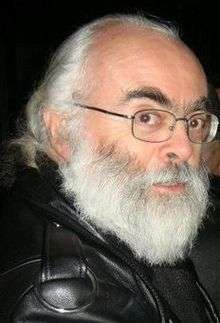Steve Munro
Steve Munro (born September 7, 1948) is a Canadian author and transit advocate from Toronto, Ontario.[2][3][4] Munro has been credited in playing a lead role in the grass-roots efforts to convince the Toronto City Council to reverse plans to abandon Toronto's remaining streetcars.[5]
Steve Munro | |
|---|---|
 Steve Munro, transit activist | |
| Born | September 7, 1948[1] |
| Nationality | Canadian |
| Occupation | Transit advocate, author, computer systems manager (retired) |
| Website | stevemunro |
Work
Munro has written several technical reports on transit.[6] Since 2006, he has written a blog that is frequently quoted by other transit commentators, and he has written a regular column for Spacing magazine and Torontoist.[7]
In 1986, Munro was critical of the decision to build a subway on Sheppard Avenue rather than a light rail vehicle line as professional transit planners recommended.[8]
In 2005, Munro was recognized for his long advocacy for improved public transit with the Jane Jacobs Medal.[4][9][10]
In 2010, while he was serving as a member of an advisory board on a proposed transit museum, Munro went public with complaints that the outgoing members of the Toronto Transit Commission were inappropriately rushing to solidify plans for the museum to bolster their personal legacies.[11]
In 2015, Munro conducted a detailed analysis of wait times on the Harbourfront route, following reconstruction of the street that took several years.[12] He found that changes to the route had increased the time to transit the route by 25 percent. In citing Munro's analysis, Edward Keenan of the Toronto Star referred to Munro's website as his "highly detailed blog". Keenan said that Munro's analysis attributed the delay to additional traffic lights, and poorly implemented and ineffective transit prioritization at those traffic lights.
References
- https://stevemunro.ca/2008/09/08/sixty/
-
Crystal Luxmore (23 August 2009). "Toronto Through the Eyes of Steve Munro". Blog TO. Retrieved 29 October 2013.
A proud trainspotter, Munro's been riding the rocket for kicks since he was a kid. He parlayed that love into a life of transit activism, crafting a reputation at City Hall for his reasoned ideas and ability to recall any streetcar on the line. It also makes him Yoda to up-and-coming urban planners and transit fans in the city, penning columns for Spacing Magazine and getting phone calls from reporters and city planners hours after publishing his latest blog post.
-
Light Rail Transit: New System Successes at Affordable Prices : Papers Presented at the National Conference on Light Rail Transit, May 8-11, 1988, San Jose, California, Issue 221. National Conference on Light Rail Transit, 1988. 1989. ISBN 9780309047135. Retrieved 29 October 2013.
The vice-chairman was Steve Munro, a computer programmer.
-
"People That Matter: Jane Jacobs Prize Recipient, Steve Munro". Ideas that matter. Retrieved 29 October 2013.
The “Streetcars for Toronto” Committee was formed in 1972 to fight for the retention and expansion of the streetcar system as a way to provide low-cost rapid transit service to growing suburban areas. As a student at the University of Toronto, Steve was part of that Committee and subsequently became its chair.
- Tess Kalinowski (20 December 2008). "Jolly old revered transit activist; Three decades after activists including Steve Munro saved city's iconic streetcars, their influence continues". Toronto Star. Retrieved 10 December 2014.
- Margaret, Daly (29 March 1979). "Let 'transit fan' sit on TTC board, Sewell urges". The Globe and Mail. ProQuest. ProQuest 387106800.
- Taras Grescoe (2012). "Straphanger: Saving Our Cities and Ourselves from the Automobile". HarperCollins. ISBN 9781443411431. Retrieved 29 October 2013.
-
Mike Smith (8 February 1986). "A subway surprise: The Sheppard line". Toronto Star. Retrieved 29 October 2013.
Transit critic Steve Munro, on the other hand, says the TTC has a "bias toward subways" and hasn't completely explored all other forms of rapid transit. "They didn't look at putting an LRT underground, for instance," Munro said. Munro is spokesman for Streetcars for Toronto, a lobby group that often battles and occasionally supports the TTC.
- Gray, Jeff (5 April 2005). "Streetcar activist wins Jacobs prize". The Globe and Mail. ProQuest. ProQuest 1366078339.
-
"TRANSIT PLANNING: A TALE OF TWO CITIES" (PDF). Rogers TV. 30 April 2013. Retrieved 29 October 2013.
In 2005, Steve was awarded the Jane Jacobs Prize in recognition of his sustained advocacy and vision for public transit in Toronto.
-
Tess Kalinowski (24 August 2010). "Transit fans critique museum plans". Toronto Star. Archived from the original on 29 October 2013. Retrieved 29 October 2013.
Longtime transit observer Steve Munro says the TTC is rushing the $5.5 million project to help justify a new head office at Yonge St. and York Mills Rd., being developed by Build Toronto.
-
Edward Keenan (15 September 2015). "Streetcars are our neglected stars: Keenan". Toronto Star. Retrieved 15 September 2015.
The transit expert and streetcar activist Steve Munro recently studied, on the highly detailed blog he keeps, the travel times of streetcars on the newly reopened Queens Quay Boulevard. Turns out that after all the rebuilding and reconstructing the street as a primarily transit-and-cycling-and-pedestrian corridor, streetcars now take longer to travel the length of that line than they did before construction began.
External links
- Official website
